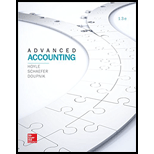
Soft Bound Version for Advanced Accounting 13th Edition
13th Edition
ISBN: 9781260110579
Author: Hoyle
Publisher: McGraw Hill Education
expand_more
expand_more
format_list_bulleted
Question
Chapter 7, Problem 2Q
To determine
Explain why is a specific ordering necessary for determining the incomes of the component corporations when an indirect ownership is present.
Expert Solution & Answer
Want to see the full answer?
Check out a sample textbook solution
Students have asked these similar questions
The manufacturing overhead cost for the current year
For last year
Accurate answer
Chapter 7 Solutions
Soft Bound Version for Advanced Accounting 13th Edition
Ch. 7 - Prob. 1QCh. 7 - Prob. 2QCh. 7 - Prob. 3QCh. 7 - How does the presence of an indirect ownership...Ch. 7 - Prob. 5QCh. 7 - In accounting for mutual ownerships, what is the...Ch. 7 - Prob. 7QCh. 7 - Prob. 8QCh. 7 - Prob. 9QCh. 7 - Prob. 10Q
Ch. 7 - Prob. 11QCh. 7 - Jones acquires Wilson, in part because the new...Ch. 7 - Prob. 13QCh. 7 - Prob. 1PCh. 7 - Prob. 2PCh. 7 - Prob. 3PCh. 7 - Which of the following is correct for two...Ch. 7 - Prob. 5PCh. 7 - Prob. 6PCh. 7 - Prob. 7PCh. 7 - Prob. 8PCh. 7 - Prob. 9PCh. 7 - Prob. 10PCh. 7 - Prob. 11PCh. 7 - Prob. 12PCh. 7 - Prob. 13PCh. 7 - Prob. 14PCh. 7 - On January 1, 2016, Uncle Company purchased 80...Ch. 7 - Prob. 16PCh. 7 - Prob. 17PCh. 7 - Prob. 18PCh. 7 - Prob. 19PCh. 7 - Clarke has a controlling interest in Rogerss...Ch. 7 - Prob. 21PCh. 7 - Prob. 22PCh. 7 - Prob. 23PCh. 7 - Prob. 24PCh. 7 - Prob. 25PCh. 7 - Prob. 26PCh. 7 - Prob. 27PCh. 7 - Prob. 28PCh. 7 - Prob. 29PCh. 7 - Prob. 1DYSCh. 7 - Prob. 2DYS
Knowledge Booster
Similar questions
- Marquis Company estimates that annual manufacturing overhead costs will be $839,000. Estimated annual operating activity bases are direct labor cost $501,000, direct labor hours 52,000, and machine hours 101,000. Compute the predetermined overhead rate for each activity base. (Round answers to 2 decimal places, e.g. 10.50.)arrow_forwardProblem related general Accountingarrow_forwardProvide correct answer this financial accounting questionarrow_forward
arrow_back_ios
SEE MORE QUESTIONS
arrow_forward_ios
Recommended textbooks for you
- Century 21 Accounting Multicolumn JournalAccountingISBN:9781337679503Author:GilbertsonPublisher:Cengage
 Intermediate Accounting: Reporting And AnalysisAccountingISBN:9781337788281Author:James M. Wahlen, Jefferson P. Jones, Donald PagachPublisher:Cengage Learning
Intermediate Accounting: Reporting And AnalysisAccountingISBN:9781337788281Author:James M. Wahlen, Jefferson P. Jones, Donald PagachPublisher:Cengage Learning

Century 21 Accounting Multicolumn Journal
Accounting
ISBN:9781337679503
Author:Gilbertson
Publisher:Cengage



Intermediate Accounting: Reporting And Analysis
Accounting
ISBN:9781337788281
Author:James M. Wahlen, Jefferson P. Jones, Donald Pagach
Publisher:Cengage Learning

